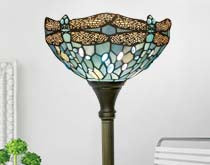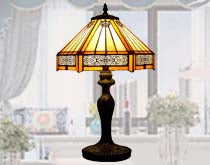Tiffany Lamp vs Tiffany Style Lamp
Louis Comfort Tiffany is one of the names that evoke a sense of elegance and exceptional craftsmanship in decorative lighting and interior design. The artist best known for his work with stained glass left an unerasable mark in decorative arts and gave rise to Tiffany lamps and Tiffany style lamps.
Tiffany and Tiffany style lamps are often confused but embody distinct features, histories and appeal. Complex nuances set the two apart, including modern-day relevance, manufacturing processes, artistic nature and origins.
The genius of Louis Comfort Tiffany marked the beginning of the journey of Tiffany lamps and Tiffany style lamps. His legacy draws inspiration from nature, the Art Nouveau and Arts and Craft movements and his works are aligned with the quest to transform stained glass into fascinating illuminated art.
The rest of this article extensively explains the different topics relating to Tiffany lamps vs Tiffany style lamps, including what they are and their similarities and differences.
Related reading: How to identify real stained glass table lamp in 2022?
What is a Tiffany Lamp?
Tiffany lamps are named after Louis Comfort Tiffany, a designer and artist who founded Tiffany Studios.The popularity of the lamps began during the Art Nouveau Movement in the1890s. Over the years, they have become more popular and valuable.
The lamps are an authentic embodiment of artistic craftsmanship and creative imagination. They are handcrafted, and the individual glass pieces are cut, shaped, soldered, or joined together using copper foil.I also mentioned earlier how Tiffany lamps are produced
The designs used in crafting the lamps are characteristic of motifs inspired by nature, especially flowers, landscapes and plants. The inspiration drawn from flowers led to the manufacturing of floral Tiffany lamp and flower Tiffany lamps shown below.

Also, the Tiffany lamps feature insidious variations in glass textures and a proportionate mix of vibrant colors.
When you acquire a Tiffany lamp, you get a highly sought-after piece and true work of art with a rich historical significance. You are most likely to get value not just for their illumination but also appreciation in value over time.
The lamps are known for their distinctive stained glass Tiffany lampshade. The lampshade helps diffuse the light from the lamps and soften them to create a warm ambience in your space.
The image below shows a stained-glass lampshade with rough gaps to compliment the decorative nature of your lamp and it obstructs the light to give a warm feel.

The historical importance and uniqueness of Tiffany lamps make them admirable, an explanation of why artisans and collectors continue to reproduce them.
Related reading: How much would an original Tiffany lamp cost?
What is a Tiffany Style Lamp?
A Tiffany style lamp is a modern adaptation and reproduction of the original Tiffany lamp and designs.
The lamps capture the central theme of Tiffany's beauty through cost-effective methods. Although they do not have the same artistic excellence as Tiffany lamps, they give you an affordable way to introduce a touch of Tiffany's elegance into your space or home.
The lamps are made using mass production approaches involving the use of machine-cut glass and assembly line processes. Such techniques make Tiffany style lamps more affordable and readily available.
Therefore, you can acquire a Tiffany style lamp if you desire the Tiffany look without having to pay the high prices of genuine Tiffany lamps.
Similarities Between Tiffany Lamps and Tiffany Style Lamps
Although the use of modern production methods in manufacturing Tiffany style lamps is an unfortunate consequence, some similarities exist between Tiffany lamps and Tiffany style lamps.
Below are the useful commonalities between the two works of art.
- Artistic value.Both works of art derive value from the skills used to create them, craftsmanship and attention to detail.
- Aesthetic design. Tiffany and Tiffany style lamps have intricate designs characterized by colorful stained glass. Moreover, in most cases, they feature unique patterns and motifs inspired by nature.
- Use of stained glass. The two types of lamps use stained glass to create their shades. The stained glass pieces are cut, shaped, and joined to form unique patterns.
- Relevance. Both Tiffany lamps and Tiffany style lamps hold a key spot in interior design. Tiffany lamps are works of art that make a statement and can be displayed in your space, museums and galleries. The desire for the lamps is because of their unmatched artistic value to any space or room.
Also, Tiffany style lamps add a touch of elegance to different interior spaces. You can get them in different sizes, colors and designs, making them easy to use to complement your space.
Differences Between Tiffany Lamps and Tiffany Style Lamps
When you come across an antique find, it is best to inspect every piece closely, especially the lamp base and shade.When you pay attention to the different characteristics of Tiffany and Tiffany style lamps, you can identify their distinguishing features.
There are several differences between Tiffany style and Tiffany lamps, including:
Origin
Louis Tiffany and Tiffany Studios designed and crafted Tiffany lamps in the 19th and 20th centuries. On the other hand, Tiffany style lamps draw inspiration from Tiffany's designs but are produced by several artists and manufacturers.
Genuineness
Tiffany lamps are original and authentic creations made by Louis Comfort Tiffany. On the contrary, Tiffany style lamps are reproductions of the original designs and may vary in quality and craft.
You can check the quality of workmanship of the lamp holder. Compared with Tiffany-style replicas, Tiffany lamps have a sense of quality.
Materials and Craft
Although both lamps use stained glass, they employ different materials and techniques. Tiffany lamps are made of high-quality materials and use elaborate techniques, while Tiffany style lamps are made of inferior materials and employ the use of different methods.
For example, Tiffany lamp base is made of heavy rings made from lead inside hollow bronze bases as shown below.

On the contrary, the base of Tiffany style lamps is made of wood, zinc, brass or even plastic as shown below.

Skillful artisans handcraft Tiffany lamps, and the excellence employed is evident in the unique variations of the lamps.
For Tiffany style lamps, manufacturing entails using machines and less labor-intensive techniques that result in uniform and less variable lamps with a more standardized aesthetic appearance.
Also, the craft of the Tiffany lamp base oozes quality, while the artistry in Tiffany style lamps is shoddy. The iconic glass-stained shade of the Tiffany lamp flows organically and is either globe or cone-shaped.
On the other hand, Tiffany style lamps are rigid regarding motifs used, botanical designs and geometric patterns. The image shown below is a Tiffany style lamp-it has a different shape from Tiffany lamps and its shade is not made of stained glass.

Value
Tiffany lamps are rare and command high prices at auctions because of their history and rarity. The style dates back years but is still consistently popular in modern, sleek interior design.
Due to their value, the lamps are treasured and collected in museums and personal spaces. The lamps have the unmatched ability to fill your space with dazzling colored light.Tiffany style lamps, on the other hand, are more accessible and not too expensive.
Period
Tiffany Studios produced Tiffany lamps in the 1890s and 1900s, and the designs reflect the doctrines of the Art Nouveau and Arts and Crafts Movements.
The style used in the manufacturing was unique and motivated by the use of rustic ancient glass. The imperfection of the glass and rich tone contributed to the excellence of Tiffany's works of art.
By 1902, Tiffany lamps were coveted by people in different parts of the world. The craftmanship showcased attention to detail and a love of nature and its beauty.
At the time, the designs featured depictions of colorful plants and flowers, and such designs still dominate the different ranges of Tiffany lamps today.On the contrary, you can find many styles and designs of Tiffany style lamps in periods beyond the original timeline.
Glass and Color Vibrance
Tiffany lamps have vibrant colors and glass designs of varied textures. If you inspect the glass of your Tiffany lamp closely, you will spot specks of color in the confetti glass.
Also, the glass pieces have an amber sheen. You can be sure of the authenticity of your Tiffany lamp by checking the glass used. The color pigment of Tiffany lamps is embedded in the glass, and it doesn't rub off easily.
On the other hand, the glass colors in Tiffany style lamps are pale and translucent, and some of the pieces of glass are painted and come off when rubbed.
Conclusion
Tiffany lamps and Tiffany style lamps differ in their authenticity, value, craft and origin.
Tiffany lamps are revered for their high artistic value and handmade excellence. However, today, Tiffany lamps represent any lamp made by putting small pieces of glass together. Such Tiffany style lamps give people more access to the beauty of Tiffany's designs.
Tiffany lamps and Tiffany style lamps are symbols of artistic illumination and can add a touch of uplifting enlightenment to your space. Tiffany lamps achieve this easily due to their exquisite designs and unparalleled workmanship.
Therefore, whether you are investing in a historic work of art or a gesture of classical design, the lamps are more likely to inspire your design enthusiasm.
Related reading: A guide to collecting Tiffany lamps



























